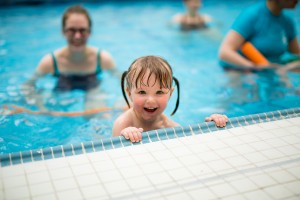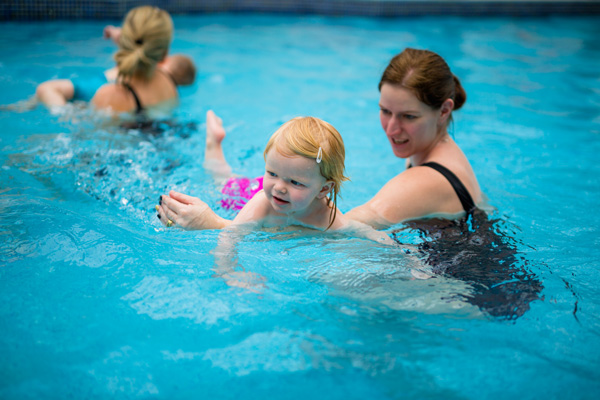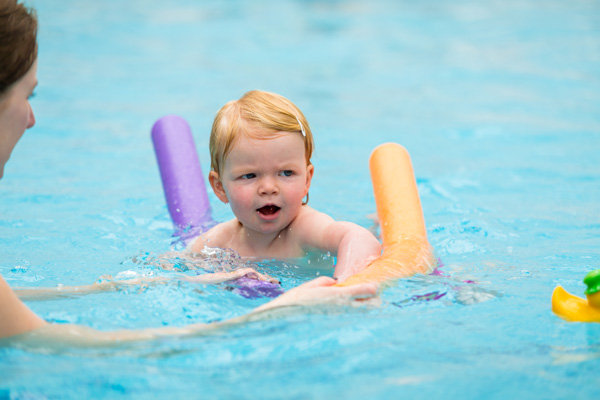5 Essential Top Tips for Taking Your Toddler Swimming for the First Time
By Ali Beckman, Technical Director and Head Teacher at Puddle Ducks  Swimming Classes
Swimming Classes
There are so many reasons to take the plunge with your toddler and start swimming with them; water confidence, respect for water and essential water safety skills are the obvious ones. However, so many other aspects of life are improved by teaching your toddler to swim; family holidays are more enjoyable, you and your toddler will meet people and make friends plus there are physical and mental benefits to swimming. Whilst there are many things to consider when you go swimming for the first time, don’t be put off by the logistics – it will be worth it! Be prepared and don’t try to do any other activity that day. 15-30 minutes in the pool will be enough for their first time – you know your toddler best! Here are my 5 essential top tips for taking your toddler swimming for the first time:
-
Decide between a structured class or a splash-about in the local pool
Many parents love the idea of taking their toddler swimming but either aren’t confident swimmers themselves or feel as though they don’t have the know-how to teach their child to swim. This can end up in a disappointing or frustrating experience for both toddler and parent. Many special swimming classes exist, which have a clear structure, including some underwater swimming (this is perfectly safe in the controlled environment of a reputable swim school). You may find this is a more enjoyable way to take your toddler swimming. The best swim classes provide an enriching environment for the parent and toddler to strengthen their bond and create happy memories associated with the water and learning to swim. If you are confident in the water and are keen on taking your toddler swimming outside of a structured class then there are lots of online videos which can help you to make the most of your time in the pool, suggested activities, hints and tips to make your time in the water as fun and productive as possible.
-
Choose the right pool
If you are taking your toddler swimming for the first time, you need to think carefully about the pool environment. First impressions are important and a cold pool could put a toddler off wanting to go again. Any pool you choose should be heated to over 28°C, be clean and well managed. Pool cleaning technology has improved, and there are several distinct types of pool cleaners to suit any pool's size or requirements. Clean pools are not uncommon nowadays. Many local authority pools have a ‘baby’ pool which is warmer and shallower than the main pool. If you are a member of a private gym with a pool, these are often warmer than average so ask if you can take your child along (there may be certain times of the week that children aren’t allowed in). If you cannot find a pool that is warm, you may want to consider a mini-wetsuit for your child. The logistics at the pool are also important; is there sufficient room in the changing rooms, do you need money for a locker, is the car parking plentiful and close to the pool?
Of course, if you want to have full control of their first experience in the water, you could always buy your own mini swimming pool for kids. These can really help little ones get used to the water, and there are a surprising number of options available, from paddling pools to big garden swimming pools!
 Any pool you choose should be heated to over 28°C, be clean and well-managed.
Any pool you choose should be heated to over 28°C, be clean and well-managed.
-
Be prepared – make sure you have all the equipment you need
Nappies.
If your toddler is still in nappies, you should employ (and most pools will insist on) a double nappy system i.e. a disposable or reusable swim nappy with a neoprene over-nappy to prevent any accidents from leaking into the pool. And don’t forget a normal nappy for after you get out the pool!
Change mat.
You might need to bring a wipe-clean change mat depending on the facilities at your chosen pool. Find out beforehand if they have baby change facilities in the changing rooms.
Goggles or not?
At Puddle Ducks, we find that as the children get older, more of them are inclined to wear goggles as they spend greater parts of their lesson with their faces in the water. However, we have very specific guidelines which may help you decide whether to give your toddler or pre-schooler goggles:
- Encourage head down swimming without goggles first. Goggles should be a last resort.
- Don’t allow young children to jump in with goggles on:
- They could slip and hurt your child’s face if not fitted properly which is often difficult with young children.
- They should regularly resurface and swim without goggles on.
- Take goggles off occasionally to “practise personal survival skills”.
- Make sure the goggles are well-fitting.
- Don’t allow a child to wear goggles if they cannot keep them on!
Snacks/drinks.
Swimming is tiring work and your little one is bound to be hungry after a session in the pool. Bring some ‘easy-to-administer’ snacks and drinks such as raisins, dried fruit or some dry cereal in a Tupperware box and your toddler’s favourite sippy cup. You’ll find it’s worth its weight in gold when you’re trying to get dressed yourself and want them to sit still for 5 minutes! If swimming for more than 30 minutes, have a drink of water poolside. You don’t realise but you perspire lots during a swimming session so it is easy to dehydrate.
Arm bands/floats/woggles.
If your goal is to teach your little one to swim, arm bands are not a good idea. If they wear armbands, they will not be aligned in the water. Their top half will be bobbing above the water, forcing their bottom half to dip down, making the alignment required for independent swimming all but impossible.
Reputable swim schools will use floats or preferably woggles (sometimes known as noodles) to help with water confidence, never arm bands. Non-fitted buoyancy aids also allow children to push away from them when they are ready to be independent whereas fitted aids (arm bands) require an adult to deflate them. We would never recommend the use of inflatables or buoyancy seats – these can flip toddlers over into the water and even land on top of them, making it difficult for them to surface.
Toys.
Swimming should be about having fun as much as learning essential life skills; a rubber duck to chase after or a ball to play with can really help with making your toddler’s first swimming experience great fun and something they are keen to repeat!
Big fluffy towel!
Your toddler will start to feel the cold as soon as they get out of the water so have a towel, preferably a hooded one, ready at the pool side (most pools have hooks to hang towels on around the edge) to wrap your toddler in as soon as you exit the pool.
-
Do some research about what to do when you are actually in the pool
It provides a better experience for everyone if you have some idea of what to do with your toddler once you are in the water. There are several resources online with suggested activities such as how to safely enter and exit the pool with your toddler and fun activities that also teach your child the fundamentals of independent swimming. If you decide to attend a structured lesson, all this is taken care of for you plus you have a teacher in the water with you to help you with the detail – definitely advisable for any parents who struggle with water confidence themselves.
-
And finally – enjoy the peace and quiet when you get home as your toddler has a great big snooze!
Try and plan your swim around your toddler’s usual sleep routine – you may be lucky and find they have a longer sleep than usual after wearing themselves out splashing you in the pool!
Ali Beckman is the Technical Director and Head Teacher at Puddle Ducks. Puddle Ducks teaches children across the UK to swim independently and beautifully, and to love and respect the water. We teach life skills and water safety to over 16,000 children, aged 0-10 years, every week. To find your nearest class visit www.puddleducks.com
